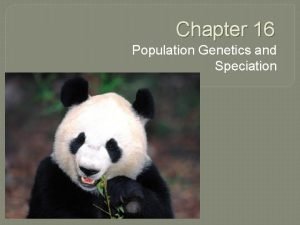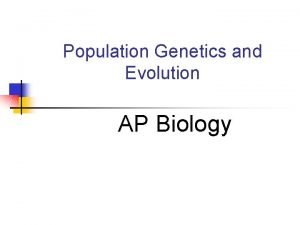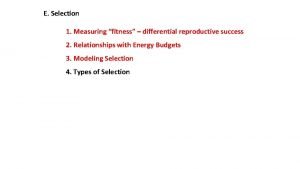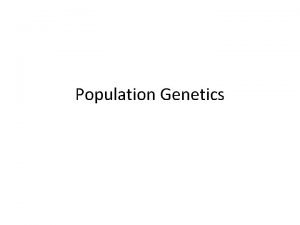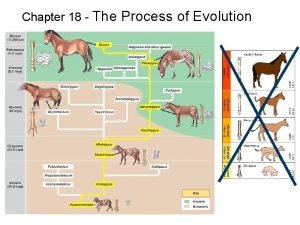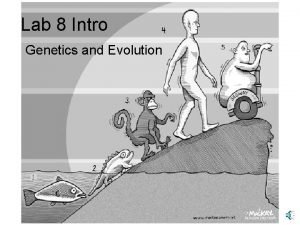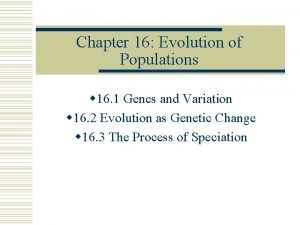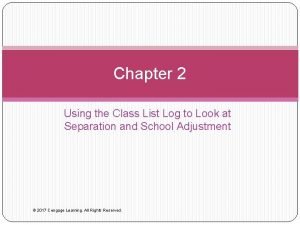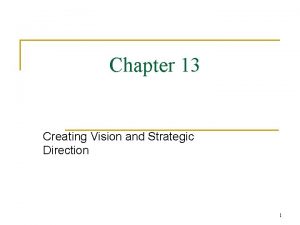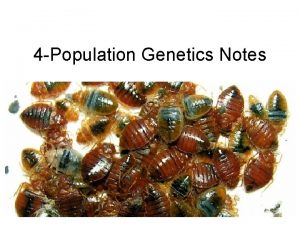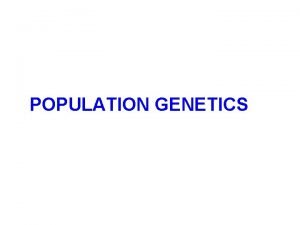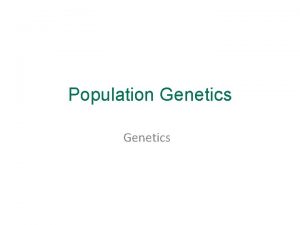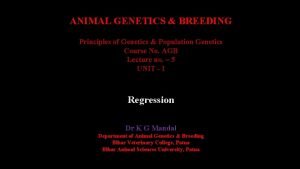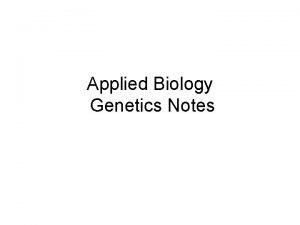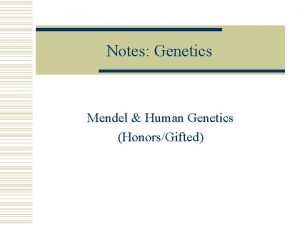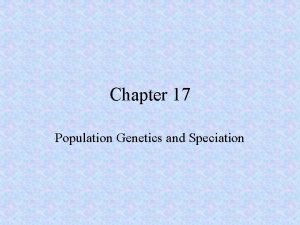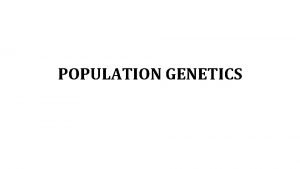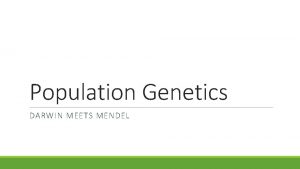3 Population Genetics Notes Population genetics focuses on




















- Slides: 20

3 -Population Genetics Notes

Population genetics: focuses on genetic changes within an interbreeding population. all the genes in a population Gene pool = ________________ Allele Frequency = Shows frequency of each allele in the gene pool (0. 625 B, 0. 375 b)

Changing the Gene Pool Microevolution: a change in a population’s gene pool over a succession of generations (a brief period of geologic time). Microevolution may be due to natural selection or other factors such as genetic drift. Genetic Drift: random change of allele frequencies in a small population due to chance , not natural selection.

migration of a small group to a Founder Effect: ___________ new area; can lead to genetic drift. ______________ Amish in America (extra digits) Example: ______________

event that drastically lowers Bottleneck Effect: an ___________ the population numbers endangered species Example: _________


Genetic Equilibrium: Allele frequencies are not no evolution changing = ________


The Hardy Weinberg principle describes a hypothetical situation in which there is no change in the gene pool (frequencies of alleles), hence no evolution. The frequencies of alleles will remain unchanged generation after generation (= NO EVOLUTION) if the following conditions are met: • Large population • Random mating • No mutation • No migration • No natural selection

The Hardy-Weinberg Equation: To estimate the frequency of alleles in a population, we can use the Hardy-Weinberg equation. p 2 + 2 pq + q 2 = 1 and p+q=1 Using the equation: p = the dominant allele frequency (represented here by A). q = the recessive allele frequency (represented here by a) For a population in genetic equilibrium: p + q = 1. 0 (The sum of the frequencies of both alleles is 1. )

The Hardy-Weinberg Equation: (p + q)2 = 1 so p 2 + 2 pq + q 2 = 1 The three terms of this binomial expansion indicate the frequencies of the three genotypes: p 2 = genotype frequency of AA (homozygous dominant) 2 pq = genotype frequency of Aa(heterozygous) q 2 = genotype frequency of aa (homozygous recessive

SAMPLE PROBLEM #1: In pigs, black coat is recessive to white. What is the percentage of heterozygotes in this population? 1. Calculate q 2: Count the individuals that are homozygous recessive in the illustration to the left. Calculate the frequency of the total population they represent. This is q 2= 4/16 = 0. 25

SAMPLE PROBLEM #1: In pigs, black coat is recessive to white. What is the percentage of heterozygotes in this population? 2. Find q: Take the square root of q 2 to obtain q, the frequency of the recessive allele. q = √ 0. 25 = 0. 5

SAMPLE PROBLEM #1: In pigs, black coat is recessive to white. What is the percentage of heterozygotes in this population? 3. Find p: The sum of the frequencies of both alleles = 1 (p + q = 1). You know q, so what is p, the frequency of the dominant allele? p=1–q p = 1 - 0. 5 = 0. 5

SAMPLE PROBLEM #1: In pigs, black coat is recessive to white. What is the percentage of heterozygotes in this population? 4. Find 2 pq: The frequency of the heterozygotes is represented by 2 pq. Multiply by 100 to calculate the percent of the population that is heterozygous for white coat: 2 pq = 2(0. 5) 2 pq = 0. 5 * 100= 50% Heterozygous


Assessment Questions: 1. What is the combined genetic information of all the members of a particular population? A. Gene pool B. Niche C. Phenotype D. Population

Assessment Questions: 2. What is a random change in a population’s allele frequency? A. A gene pool B. Genetic drift C. Variation D. Fitness

Assessment Questions: 3. What is a change in allele frequency that results from the migration of a small subgroup of a population called? A. Natural selection B. Hardy Weinberg Principle C. Founder Effect D. Genetic Equilibrium

Assessment Questions: 4. In a population with two allele, B and b, the allele frequency of b is 0. 4. B is dominant to b. What is the frequency of the individuals with the dominant phenotype if the population is in Hardy Weinberg equilibrium? A. 0. 16 B. 0. 36 C. 0. 48 D. 0. 84
 Population genetics and speciation worksheet answer key
Population genetics and speciation worksheet answer key Genetics
Genetics Population genetics
Population genetics Genetics
Genetics The far side comics
The far side comics Similar
Similar Population genetics
Population genetics Principles of romanticism
Principles of romanticism Developing competitive advantage and strategic focus
Developing competitive advantage and strategic focus Scheduling time-constrained projects focuses on resource
Scheduling time-constrained projects focuses on resource Developing a firms strategy canvas focuses on
Developing a firms strategy canvas focuses on Sociology of physical activity focuses on
Sociology of physical activity focuses on Management focuses on
Management focuses on Literary analysis lenses
Literary analysis lenses Organizational restructuring
Organizational restructuring A class list log focuses on
A class list log focuses on This chapter focuses on
This chapter focuses on Creating vision and strategic direction
Creating vision and strategic direction What is a class list log
What is a class list log 14 line sonnet poem about love
14 line sonnet poem about love Informative writing focuses
Informative writing focuses
